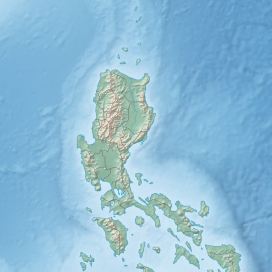The Apolaki Caldera is a volcanic caldera with a diameter of 150 kilometers (93 mi), making it the world's largest caldera. It is located within the Benham Rise (Philippine Rise) and was discovered in 2019 by Jenny Anne Barretto, a Filipino marine geophysicist and her team. The name "Apolaki" means "giant lord" in Filipino, and is also the name of the god of sun and war in some pantheons in Philippine mythology and the indigenous Philippine folk religions.[1][2] The volcano has been inactive for millions of years.[3]
| Apolaki Crater | |
|---|---|
| Highest point | |
| Coordinates | 16°30′N 124°45′E / 16.500°N 124.750°E[citation needed] |
| Geography | |
| Location | Philippine Sea |
| Country | Philippines |
| Geology | |
| Mountain type | caldera |
Geological history
editGravimetric analysis shows that the Philippine Rise, as the submarine mountain massif is named, is made of a nine mile thick layer of magmatic and volcanic rocks. Rock samples ages range from 47.9 to 26 million years, when volcanic activity made up the massif.[4][5]
References
edit- ^ Mangosing, Frances (October 21, 2019). "Filipina scientist discovers 'world's largest crater' in Philippine Rise". Philippine Daily Inquirer. Archived from the original on December 10, 2019.
- ^ "Filipina scientist discovers world's largest crater on Benham Rise". ABS-CBN News. October 21, 2019. Retrieved October 21, 2019.
- ^ Viernes, Franchesca (2022-01-19). "Did you know that the largest volcano caldera in the world is in the Philippines?". GMA News Online. Retrieved 2023-07-25.
- ^ Bressan, David (October 21, 2019). "The World's Largest Caldera Lays Hidden In The Philippine Sea". Forbes. Retrieved October 22, 2019.
- ^ Barretto, Jenny; Wood, Ray; Milsom, John (2020-01-01). "Benham Rise unveiled: Morphology and structure of an Eocene large igneous province in the West Philippine Basin". Marine Geology. 419: 106052. Bibcode:2020MGeol.419j6052B. doi:10.1016/j.margeo.2019.106052. ISSN 0025-3227. S2CID 210318502.


